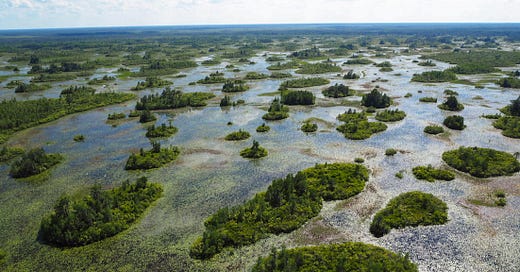Victory at the Edge of the Swamp
A six-year fight to save a natural wonder ends with a stunning deal.
I know it’s been a fire hose of disastrous environmental news lately, so here’s something truly uplifting.
After six long years, the plan to mine next to Georgia’s Okefenokee Swamp is dead.
The Conservation Fund, with support from philanthropic groups like the Holdfast Collective and the James M. Cox Foundation, has purchased every inch of land Twin Pines Minerals had assembled for its titanium oxide mine, including the mineral rights. The deal permanently halts a project that scientists warned could irreparably damage one of the most extraordinary wetland ecosystems on Earth.
It’s over. The bulldozers won’t come. The peat won’t be drained. The swamp is safe, for now.
And that’s worth pausing for and celebrating. Because in this bleak moment, a conservation miracle just happened.
A Blackwater Cathedral, Spared
The Okefenokee is not just a swamp. It’s a living cathedral. A vast, slow-moving expanse of water and peat and tangled cypress that stretches more than 400,000 acres across southeastern Georgia and into Florida. It’s home to red-cockaded woodpeckers, indigo snakes, and nearly 15,000 alligators. It cradles the headwaters of the Suwannee and St. Marys Rivers. It stores millions of tons of carbon beneath its floating islands of peat.
And it is wholly unique. There is nothing like it anywhere else in North America.
For years, that uniqueness has put a target on its back.
What Almost Happened
Twin Pines Minerals, a company with no meaningful track record and a deeply controversial permitting history, wanted to build a titanium oxide mine directly on Trail Ridge, a geological formation that helps regulate the water table of the entire swamp. (Titanium oxide is a common industrial whitening pigment used in everything from toothpaste to Oreo filling.)
The mining would’ve withdrawn groundwater from beneath the swamp, threatened the flow of its rivers, and dramatically increased the odds of drought and wildfire. Twin Pines had also been repeatedly fined for air pollution violations and the mine threatened to destroy the water quality the entire Okefenokee ecosystem depends on.
Scientists from UGA and the federal government sounded the alarm. Georgians across the political spectrum spoke out.
But the project just kept moving forward.
And by this spring, it looked all but inevitable. Georgia’s EPD had issued draft permits. The company was poised to start digging.
Then came the land deal. Quietly negotiated and decisively executed. And just like that, the permits became meaningless. There would be no mine, because there was no longer any land to mine.
How It Was Won
This victory belongs to the people of Georgia, and to the swamp itself.
It was won by scientists who sounded the alarm. By lawyers who fought the permits. By local citizens who packed meetings and flooded inboxes. By funders who stepped up with real money when it counted. By conservationists, hunters, anglers, and ordinary people who refused to give up. And by politicians like Senator Jon Ossoff (D-GA) who worked tirelessly to protect the swamp and speak out about the dangers the mine posed.
And it was won by the Okefenokee itself, by its majesty, by its stubborn wildness, by the way it grabs hold of those who visit and never really lets go.
The Threat Isn't Over
I wish I could tell you this meant the Okefenokee was protected for good, but I can’t. As good as this news is, the fight isn’t finished.
Twin Pines is out. But Trail Ridge remains largely in private hands, and new mining proposals could emerge tomorrow. The state legislature still hasn’t passed the Okefenokee Protection Act, a simple, popular bill that would ban mining on the swamp’s doorstep, and yet year after year, Republican leadership has refused to bring it to a vote.
Let’s be clear: we shouldn’t have to fundraise and negotiate our way out of every new disaster. This landscape deserves durable, legal protection. Permanent protection. Anything less is just irresponsible.
What Comes Next
The swamp has been nominated for UNESCO World Heritage status, and this land deal adds momentum to that bid. The Biden administration supported the UNESCO bid, now leaders and politicians from across the spectrum are urging Doug Burgum to continue to support the UNESCO bid. Even Sonny Purdue, a former GA governor and Trump’s Secretary of Agriculture from his first term has urged the administrationt o support the UNESCO designation.
More than anything though, the Okefenokee needs permanent protection. It needs politicians to summon the courage and the will to protect one of the most incredible natural features of planet earth.
Because the next mining company will be slicker. Better funded. Smarter about PR. And they’ll wait until the cameras are gone and the pressure has dissipated. That’s how these fights go.
But today, the bulldozers are quiet. The water flows undisturbed. The alligators slide through the reeds, and the egrets lift from the shallows into the early summer heat, unaware, maybe, that the world just tilted back in their favor.
Let’s keep it that way.
—Jim








Now we need that to happen for the Boundary Waters
Jon Ossoff is a blessing to be blessed. He works tirelessly on behalf of the people of Georgia. And, he has this “radical” idea that public servants ought to serve the public. The Republicans call that socialism and I have no doubt that they’ll spend the next eighteen months trying to paint Senator Ossoff as some wild-eyed radical who wants to raise taxes on everyone while unleashing murderous foreigners on the poor, unsuspecting people of Georgia. The Republicans excel when it comes to lying and don’t trust any politician who hasn’t been bought and paid for by the big corporations. As for me, I see a Senator who actually gives a damn about the people who elected him. What we need, are more Jon Ossoffs and fewer Trumpanzees.